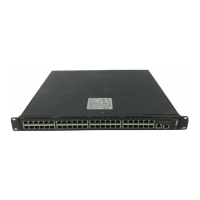Layer 2,3,IPv6+QoS Switch
_____________________________________________________________________________
Layer 2,3,IPv6+QoS Network Switch User Manual Version 0.1 Page: 944/970
immediately. These changes will not be retained across a power cycle unless a save is
performed.
11.2.7.2.2. Configuring IGMP Interface Configuration Page
Selection Criteria
Slot/Port - Select the slot and port for which data is to be displayed or configured from the
pulldown menu. Slot 0 is the base unit. You must have configured at least one router
interface before configuring or displaying data for an IGMP interface, otherwise an error
message will be displayed.
Configurable Data
Interface Mode - Select enable or disable from the pulldown menu to set the administrative
status of IGMP on the selected interface. The default is disable.
Version - Enter the version of IGMP you want to configure on the selected interface. Valid
values are 1 to 3 and the default value is 3.
Robustness - Enter the robustness value. This variable allows tuning for the expected
packet loss on a subnet. If you expect the subnet to be lossy, you should enter a higher
number for this parameter. IGMP is robust to (robustness variable-1) packet losses. Valid
values are from 1 to 255. The default value is 2.
Query Interval - Enter the frequency in seconds at which IGMP host-query packets are to
be transmitted on this interface. Valid values are from 1 to 3600. The default value is 125.
Query Max Response Time - Enter the maximum query response time to be advertised in
IGMPv2 queries on this interface, in tenths of a second. The default value is 100. Valid
values are from (0 to 255) .
Startup Query Interval - Enter the number of seconds between the transmission of startup
queries on the selected interface. The valid values are from 1 to 300. The default value is
31.
Startup Query Count - Enter the number of queries to be sent on startup. The valid values

